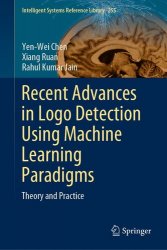Recent Advances in Logo Detection Using Machine Learning Paradigms: Theory and Practice
- Добавил: literator
- Дата: 1-06-2024, 03:54
- Комментариев: 0
 Название: Recent Advances in Logo Detection Using Machine Learning Paradigms: Theory and Practice
Название: Recent Advances in Logo Detection Using Machine Learning Paradigms: Theory and PracticeАвтор: Yen-Wei Chen, Xiang Ruan, Rahul Kumar Jain
Издательство: Springer
Год: 2024
Страниц: 128
Язык: английский
Формат: pdf (true), epub
Размер: 32.9 MB
This book presents the current trends in Deep Learning-based object detection framework with a focus on logo detection tasks. It introduces a variety of approaches, including attention mechanisms and domain adaptation for logo detection, and describes recent advancement in object detection frameworks using Deep Learning. We offer solutions to the major problems such as the lack of training data and the domain-shift issues.
In recent years, there has been a notable transition from rule-based Artificial Intelligence (AI) to Machine-Learning-based AI, with an increasing focus on Deep Learning. Currently, Deep Learning frameworks are at the forefront of AI technology, marking significant advancements in academic and industrial fields. The evolution of deep convolutional neural networks (CNNs) has positioned deep learning as the method of choice for computer vision tasks, including image classification, segmentation, object detection, and human keypoint detection. This surge in Deep Learning has sparked interest in applying Convolutional Neural Networks (CNNs) across various domains, including the task of logo detection.
A logo is a unique symbol which identifies the product and services of any company. Logos serve as the quintessential elements for brand identity in today’s market, symbolizing a company’s products and services while setting them apart from competitors. Consequently, automatic logo detection in real-world images has emerged as a critical challenge with substantial implications across numerous applications, such as brand management, copyright protection, advertisement, and market analysis. To date, various logo recognition methods have been proposed, but most of them require huge annotated datasets for training, posing significant challenges due to domain discrepancies between training (source domain) and testing (target domain) datasets. These discrepancies often result in suboptimum detection accuracy. In this book, we aim to document recent advancements and explore future directions for Deep Learning in logo recognition. This book introduces:
• (1) A weakly supervised logo detection approach leveraging attention mechanisms, which emphasizes key features and identifies logo positions without need of detailed object-level annotations.
• (2) A robust logo detection framework, incorporating a feature extraction network enhanced with spatial and channel attention modules, coupled with an anchor-free detection head for precise and efficient logo identification.
• (3) Strategies to address the domain shift problem between training and testing data by integrating domain adaptation methods into detection frameworks, improving accuracy across different logo datasets.
• (4) An innovative domain adaptation technique based on entropy minimization to bridge the domain gap between synthetic (simulated) and real logo images, facilitating unsupervised logo detection suitable for practical application.
This book also provides valuable insights into feature learning and the application of various Deep Learning frameworks in logo recognition through detailed experiments and analyses, offering readers a comprehensive understanding of Deep Learning and logo detection.
This book provides numerous ways that deep learners can use for logo recognition, including:
Deep Learning-based end-to-end trainable architecture for logo detection
Weakly supervised logo recognition approach using attention mechanisms
Anchor-free logo detection framework combining attention mechanisms to precisely locate logos in the real-world images
Unsupervised logo detection that takes into account domain-shift issues from synthetic to real-world images
Approach for logo detection modeling domain adaption task in the context of weakly supervised learning to overcome the lack of object-level annotation problem.
The merit of our logo recognition technique is demonstrated using experiments, performance evaluation, and feature distribution analysis utilizing different Deep Learning frameworks.
The book is directed to professors, researchers, practitioners in the field of engineering, Computer Science, and related fields as well as anyone interested in using Deep Learning techniques and applications in logo and various object detection tasks.
Скачать Recent Advances in Logo Detection Using Machine Learning Paradigms: Theory and Practice
Внимание
Уважаемый посетитель, Вы зашли на сайт как незарегистрированный пользователь.
Мы рекомендуем Вам зарегистрироваться либо войти на сайт под своим именем.
Уважаемый посетитель, Вы зашли на сайт как незарегистрированный пользователь.
Мы рекомендуем Вам зарегистрироваться либо войти на сайт под своим именем.
Информация
Посетители, находящиеся в группе Гости, не могут оставлять комментарии к данной публикации.
Посетители, находящиеся в группе Гости, не могут оставлять комментарии к данной публикации.
